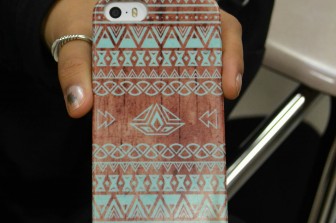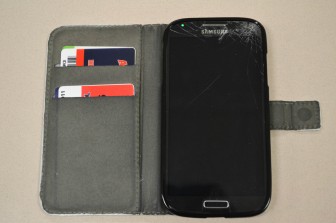
Cheering atop the bleachers during a rally, senior Avery Gonzalez jumped and accidentally hurled his phone through the air. It hit a light in the ceiling and ultimately plummeted to the ground. Thanks to his Lifeproof case, Gonzalez walked away without a single crack in his phone.
Besides protecting his phone from potential falls, Gonzalez’s case allows him to take pictures underwater while swimming. However, Gonzalez currently does not have a case on his phone because he no longer has an iPhone. He says, “I think finding a case for anything that isn’t an iPhone is harder to find. That’s why I don’t have one right now.”
Although not having the protection of a case is risky, it also has benefits. Gonzalez continues, “[My phone] just slides right into my pocket, [unlike] something bulky.”
Junior Isabella Duan began using a smartphone at the beginning of her sophomore year, and she believes that being a new user affects the way she sees phone cases; she says, “Because I got my phone recently, I want to preserve it. I feel like if you’ve had your phone for a long time, and you don’t really care about it, you wouldn’t use a case or you would use a less protective case. You would be less cautious. If you just got a phone, you’d definitely put a case on it.”

In addition to cases, students use screen protectors as an extra layer of protection. Sophomore Kelsey Dobbs has a blue and gray case with a glass screen protector on her phone, saying, “I like that because if I drop [my phone], I won’t have a panic attack about it cracking because I know it will just crack the screen protector.”
Students sometimes have smartphone cases in order to add a personalized or stylish look. Freshman Jocelyn Lee, who has a simple purple case, comments, “It protects my phone, [but] it’s not bulky. I’m looking for protection for my phone, but I’m also looking for [what] the protection looks like.” When cases are especially protective, they may take a toll on the feel or appearance of the phone, generating concerns; some smartphone users may want to achieve a balance between the two.
Many smartphone cases have evolved from mere protection to fashion statements. Although Duan has a plain gray case, she still appreciates the single color aesthetic. Duan says, “I don’t want to have a really colorful phone case because I don’t want it to match with my outfit. Neutral colors work.”
Freshman Kimberly Woo has a unique phone case with a blue 3D cartoon Stitch design, and finds comfort in it, saying, “It feels nice to hold. Because it has the back part of it, the pop-out, it is inclining. It inclines forward so I don’t really need to look bird’s eye view [to see the screen].” Even though Woo believes that the pop-out is convenient, she thinks the case itself causes more complications; she has a difficult time clicking her lock screen and volume buttons due to the small slits on the sides of her case.
Besides protection and appearance, some cases can be used functionally. Junior Elaine Mangini has a phone case that doubles as a wallet, and despite being bulky, it still looks fashionable. Mangini says, “[My case] is pink, and it has flowers on it; they are colorful and pretty. I like that it holds all my money and my don dollars. I’ve used the wallet ones ever since I got my license, because otherwise I would forget it.”.

Duan previously had a white case with a flap that covered her screen. The flap’s purpose is to protect the screen and lock the phone, but it has drawbacks as well. Duan comments, “It’s convenient because you don’t have to press the power button, but it’s also annoying because sometimes the flap just moves a little bit and your phone turns on. I feel like it wastes a lot of battery because your phone is on for half the day even though you’re not using it.”
Woo also thinks that the material of the case affects the quality and effectiveness of the phone case. “I don’t really like getting the plastic cases because I feel like those break easier.” Her phone case is made of flexible rubber that does not break easily.
Similarly, Mangini notices the differences between the material of cases; she claims that she buys a new phone case about every three months because they break often. Since her cases become damaged easily, she buys lower-priced cases. Mangini says, “I won’t buy [a phone case] over fifteen dollars. I can find the same thing on Amazon for ten dollars; it works as well as the $50 one.”
However, Gonzalez is willing to pay more for a more quality case that is capable of protecting against any environment and situation, like the rally incident. Gonzalez bought his Lifeproof case for $80. Gonzalez says, “[The Lifeproof case] was on discount; [I] bought the case for $20 off, so I’m just paying $60 instead of $80. So, it’s a good price. It just makes more sense to spend more money on a durable case that can pretty much take anything.”
As reflected by the numerous and individual cases students use, sales of mobile phone cases had grown 17 percent in 2013, and continue to increase, according to NPD Group. The demand for phone cases steadily escalates as new trends arise from brands such as Speck, Otterbox, and Kate Spade, each catering a unique type of case that addresses the need for protection, personalization, convenience, and comfort.




